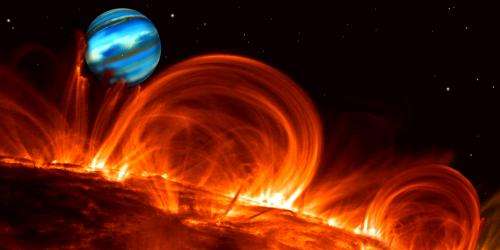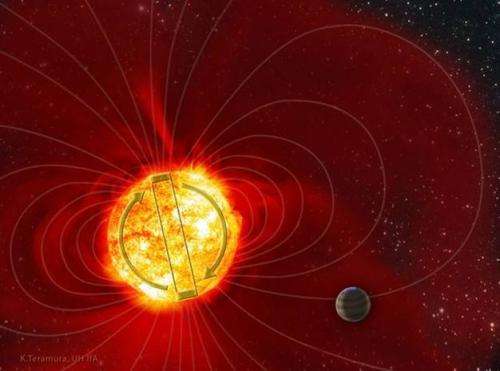Star Tau Boo's baffling magnetic flips

(Phys.org) —The first observations of the complete magnetic cycle of a star other than the Sun are proving a puzzle to astronomers. Tau Boötis, known as Tau Boo (τ Boo), is a yellowish star that is a little brighter than our Sun. It is located 51 light years away in the constellation of Boötes. It is host to a giant exoplanet about six times the mass of Jupiter, which orbits Tau Boo every 3.3 days.
In 2007, the magnetic field of Tau Boo was seen to flip: the first time this was observed to happen in a star other than the Sun. Since then the team has observed four reversals in polarity and is now able to confirm that the star has a rapid magnetic cycle of no more than two years – compared to 22 years for the Sun. This cycle will subject the orbiting hot-Jupiter to very fast changes in its surrounding environment. Dr Rim Fares will present findings at the National Astronomy Meeting in St Andrews on Thursday 4 July.
"The Sun's magnetic field is a bit like a giant bar magnet, with a north pole and south pole. Every 11 years, during solar maximum (the peak of sunspot activity), the Sun's poles swap over. It takes two flips to restore the magnetic field to its original orientation, so the Sun's magnetic cycle lasts 22 years," explained Dr Fares. "Tau Boo has the same magnetic behaviour as the Sun, but its cycle is very fast compared to the solar one. We've seen changes at regular intervals of about a year that are clearly not chaotic, so we can now be sure that we are looking at the star's magnetic cycle lasting at most two years."
The reasons for Tau Boo's fast cycle are still unclear. As well as having the only proper cycle yet observed, Tau Boo is also unique in being the only star where magnetic reversals have been seen that is orbited by detected planets.
Dr Fares and her colleagues made the discovery whilst undertaking a mini-survey of 10 stars orbited by hot-Jupiters, massive Jupiter-like planets that orbit very close to their star and experience scorching temperatures. Observations of the stars' magnetic fields were compared to observations of stars without hot-Jupiters. The team aimed to understand how the magnetic environment of stars affects the planets embedded within them and whether the planets themselves have an influence on the magnetic behaviour of the star.

"A star's magnetic field can have powerful effects on a planet, causing aurora and evaporation (at least partially) of the atmosphere. To understand these phenomena, we should understand the different interactions at play and how they affect both the planet and the star," said Dr Fares. "Unfortunately, observing the planets is a really challenging task, so we decided to study the magnetic fields of the stars that host hot-Jupiters and see whether they were influenced by interactions with the planets."
Even so, stellar magnetic fields can be small and are hard to detect. Out of the sample of 10 stars, the team was not able to detect the fields of three stars. In the other seven stars, they detected magnetic fields and found (aside from Tau Boo) that they had properties similar to stars without planets.
"For three stars in the sample, we had more than one epoch of observations, so we could actually follow how their magnetic fields changed with time and compare it to stars without hot-Jupiter. We found that, aside from Tau Boo, the magnetic field properties were just like those of stars without planets. For Tau Boo, tidal interactions between the star and the planet might be an important factor in accelerating the cycle, but we can't be sure of the cause," said Dr Fares.
Tau Boo spins on its axis once every 3.3 days – the same period as its hot-Jupiter completes one orbit. The vast planet is just ten times more massive than the total mass of the outer layers of the star. One hypothesis for Tau Boo's rapid cycle is that the planet is dragging on the star, making it rotate faster than usual, and this is affecting the generation of the magnetic field.
"There are still some big questions about what's causing Tau Boo's rapid magnetic cycle. From our survey, we can say that each planetary system is particular, that interactions affect stars and planets differently, and that they depend on the masses, distance and other properties of the system," explained Dr Fares.
Provided by Royal Astronomical Society




















